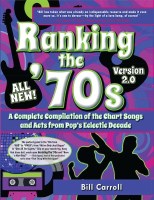
 I’m having a lot of fun with Ranking the ’70s, Version 2.0. Author Bill Carroll, after a career in chemical engineering/consulting, turned his attention to chart books. (He’s still an adjunct professor at Indiana University.) He reworked this one last year and has just published Ranking the ’90s: Country – The Decade Country Went Mainstream.
I’m having a lot of fun with Ranking the ’70s, Version 2.0. Author Bill Carroll, after a career in chemical engineering/consulting, turned his attention to chart books. (He’s still an adjunct professor at Indiana University.) He reworked this one last year and has just published Ranking the ’90s: Country – The Decade Country Went Mainstream.
Carroll spins off his rankings of all 5,315 charted Billboard Hot 100 singles of the decade and all 5,941 albums into numerous other charts: Lowest Scoring No. 1s; Weakest Follow-Ups to No. 1s; Biggest ’70s Covers of ’50s/’60s Hits; Top Instrumentals; Singles-Driven vs. Album-Driven Artists; Top Writers and Producers.
What got my attention though was not the top of the singles rankings as much as the bottom 100: songs No. 5215 through 5315. None peaked higher than No. 95. The last 10 or so were the songs that spent a single week at No. 100. And while poring over that list might seem like a job for only the really, er, devoted, there are both treasures and curios.
Songs we’ve all heard of now, but by somebody else. There’s the pre-Doobies “Jesus Is Just Alright” by the Byrds. The Country hit version of Marshall Tucker Band’s “Can’t You See” by Waylon Jennings. Also, the Slade original of “Cum On Feel the Noize,” a song more Americans have probably heard about since the Quiet Riot hit than actually heard. Another international hit that fizzled here, “One Man Band” by Leo Sayer, is a song that endured for years on Classic Hits radio in the UK.
Left-field covers and remakes: Peaches & Herb’s “The Sound of Silence”; Edwin Hawkins Singers vocalist Dorothy Morrison’s “Spirit in the Sky”; Wilson Pickett’s “Mama Told Me Not to Come.” The Country hit remake of “Solitary Man” by T.G. Sheppard is the lowest-ranking song at No. 5315. In an era when A&R often involved covering an album cut by a better-known artist that hadn’t become a single, there is Stevie Wonder’s “Happier Than the Morning Sun” by B.J. Thomas and Neil Young’s “Tell Me Why” by [Ian] Matthews’ Southern Comfort.
Losing versions of a cover battle. 1975’s disco-fied remake of “Love Hurts” by Jim Capaldi was eclipsed shortly by Nazareth’s power ballad version. Revelation’s “You to Me Are Everything” failed to become a U.S. hit, but so did the UK smash by the Real Thing, a song still unavoidable on the radio there.
Pre-stardom hits: The O’Jays were already working with Gamble & Huff on 1970’s “Looky Looky (Look at Me Girl),” but were a few years from following them to Philadelphia International. Rick Springfield had already nominally broken through with the infamously hyped “Speak to the Sky,” but he was already on another label a year later for “American Girls.”
Then there’s the song that counts as both a pre-stardom hit and a losing version of a cover battle. 1976 saw two different songs by the same artist compete with themselves. One was the old and re-recorded versions of Bobbie Gentry’s “Ode to Billy Joe.” The other was Sweeney Todd’s “Roxy Roller.” When the original Canadian hit version was used in America to launch Nick Gilder’s solo career, it competed with a re-recorded version where Gilder was replaced by one Bryan Guy Adams. Neither version was a hit here, but Gilder’s version — an equally perverse prequel to “Hot Child in the City” — still plays on Canadian radio.
There is the Partridge Family trying to rock harder on “Friend and a Lover.” There are the remaining members of the Monkees, after a hard-fought battle for credibility, cheerfully returning to bubblegum on “Oh My My” with the help of the Archies team, Andy Kim & Jeff Barry.
There are R&B and disco classics that just didn’t happen to cross over, such as Bohannon’s “Foot Stompin’ Music.” There’s the KC & the Sunshine Band-produced “Where Is the Love” by Betty Wright, which Harry Wayne Casey once (credibly) told an interviewer was his “River Deep Mountain High”-style lost masterpiece.
Another acknowledged masterpiece, Love’s “Alone Again Or,” is from 1968, but was reissued in 1970. It’s not the only ’60s song to resurface; there’s also a Turtles version of “Eve of Destruction” from their first album, but also made a single in 1970.
Not all the songs mentioned here are still available via streaming, but enough are to make for a great playlist. Please enjoy “The Best of the Bottom 100 of the ’70s.”
